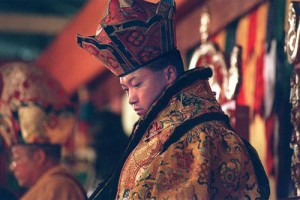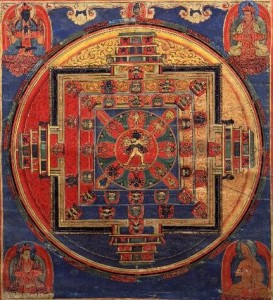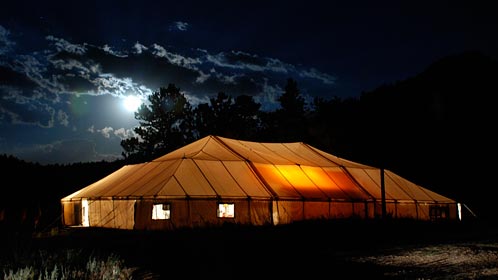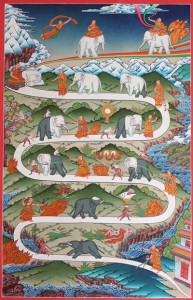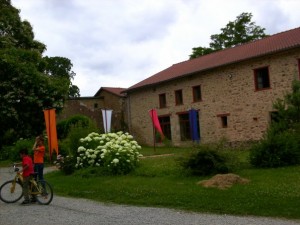Monday
Featured Stories, Sakyong and FamilyTWENTY YEARS OF RULING AND TEACHING: Part Two – Empowerment
By Shastri Benoît Côté
The Sakyong has told the story of H. H. Penor Rinpoche making the long journey from Namdroling, his main monastery in South India, to visit H. H. Khyentse Rinpoche in Nepal. It was “about him.” They agreed that when Khyentse Rinpoche would pass away, Penor Rinpoche would become the Sakyong’s teacher. Khyentse Rinpoche passed away in September of 1991, and H. H. Penor Rinpoche became then the supreme head of the Nyingma lineage. In the fall of 1994, the Sakyong went to Namdroling as part of the preparations for his Sakyong empowerment that Penor Rinpoche was to perform in the spring of 1995. It was then announced that Penor Rinpoche had recognized him as the tulku of the great Mipham Rinpoche, the famous 19th century Tibetan Buddhist master, who was considered an emanation of Majushri, the bodhisattva of wisdom. This echoed the refuge name “Mipham Lhaga,” that the Vidyadhara had given to the young Sakyong, years before. Mipham the Great authored a voluminous corpus used in all sects of Tibetan Buddhism, and prophesized that he would be reborn “in Shambhala.”
In May 1995, the Sawang Ösel Rangdrol Mukpo was enthroned as Sakyong, “Earth Protector”, becoming formally the holder of the Shambhala lineage initiated in the west by his father. In 1979, at age 17, he had been invested as Sawang, “Earth Lord”, by the Vidyadhara, in a ceremony held in Boulder. He had become the future Sakyong, heir to the Shambhala lineage. Now he was to be known as Sakyong Jamgön Mipham Rinpoche, with the full responsibility to look at the establishment and further unfolding of that lineage. The Vidyadhara himself, the Druk Sakyong, had received this empowerment in Boulder from H. H. Dilgo Khyentse Rinpoche in 1982. In that case, the ceremony had been restricted to the “lodge members,” the senior students who had been introduced to the higher Shambhala teachings.
This time there was no secret. The ceremony happened in Halifax within a nine-day festival called “Joining Heaven and Earth” that gathered over 3000 students from all over the world. It was also attended by various political and official figures, and was reported in the local and national media. As was told at that time, by doing that the Sakyong “turned the whole thing inside out.” It was a proclamation of the kingdom of Shambhala as an actual presence in the world, and in particular in Nova Scotia. The gathering ended with H. H. Penor Rinpoche performing the Kalachakra empowerment, which according to tradition is the teaching received by the first king of Shambhala, Dawa Sangpo, when he went to see Shakyamuni Buddha and asked if there was a spiritual path for someone who does not want to leave society. It is said that the Buddha taught him the Kalachakra tantra, which mentions the notion of enlightened society and the name Shambhala.
One month later, on June 26, the day of the anniversary of Mipham the Great, The Sakyong wrote his first sadhana, or liturgical text, called “The Windhorse of Authentic Presence, Arousing the Confidence of Warrior-King Gesar.” Later that summer, he introduced this practice to the participants of the first, and only, one-month Shambhala Seminary, an advanced program for people who had gone through the Shambhala Training path.
* * * * *
In the summer of 1996, Sakyong Mipham Rinpoche taught his third three-month seminary. This time he gave all the talks. In 1992 and 1994, transcripts were published for the vajrayana talks only. This time, there were transcripts for all three parts, hinayana, mahayana and vajrayana. Although keeping the form established by the Vidyadhara of a talk followed by questions and answers, the Sakyong gave longer talks drawing in the rich traditional topics that he had been studying, in particular what is referred to as the “grounds and paths.” He introduced the four so-called schools or tenets of the Buddhist view, and gave a detailed presentation of the mahayana teachings on relative and absolute bodhichitta. His approach was precise without being technical or scholarly oriented, and often humorous. He was transmitting meaning beyond words. In the third part, his presentation of how to enter into the vajrayana culture has become part of how students have been prepared for Vajrayana Seminary for many years now.
In 1996, he also empowered the first group of acharyas, senior teachers becoming lineage teachers with the power to give refuge, and later, bodhisattva vows. That was a big step in acknowledging those teachers and extending the whole teaching situation.
In the summer of 1997, he presided over the first and only “Vajrayana Seminary,” a term that is used differently now. The Vidyadhara had at several times expressed his intention to hold such a program that was intended as further training for people who had already completed the three-month seminary. But it never happened. In this case, it was a three-week program with Khenpo Namdrol, one of the main teachers of the Sakyong at Namdroling Monastery, teaching the first week. Khenpo Tsultrim Gyatso Rinpoche, the famous yogin/scholar that had met the Vidyadhara in 1985 and was now teaching a lot in our sangha, taught the second week. The Sakyong taught the third. Transcripts of his talks were published under the title, “The Path of Luminosity and Emptiness.”
During those years, the Sakyong was teaching a lot about mahayana. It might have had something to do with the difficulties and tensions that were still happening within the sangha. At the end of October 1997, he taught a public seminar at Karmê Chöling that became the basis for a sourcebook called “Rousing Bodhichitta.” The first two paragraphs start with:
Welcome. Some of you are involved in Shambhala Training, and others are practicing Buddhism – some for a longer period of time and others shorter. This weekend, my hope is to have a simple and basic discussion of how to do the bodhichitta practice of generating loving-kindness, to talk about its intricacies, and altogether to raise the level of curiosity about contemplative practice. (…)
There’s a tendency to want to attain enlightenment, to want to do this or that practice, which is fine in terms of exertion. However, when we are asked, “What about everyone else?” we say, “Forget about everyone else. They can work it out. I’m practicing; I’m meditating on compassion. Don’t disturb me. I’m developing equanimity, and you’re upsetting me.” [Laughter]
One can see here the beginning of what would become a very strong emphasis on contemplative practice. At some point in late 1997 or early 1998, the Sakyong left for Asia, for what would become probably his longest period of practicing and studying there.
* * * * *
The Sakyong came back just in time to teach the 1999 three-month seminary. There he surprised everybody by giving very long talks, sometimes five to six hours, with or without a pause. In his opening address, he said:
The reason for continuing to receive these teachings is to understand thoroughly the view of what we are doing. In a sense you could say we’ve all received everything already, but that’s just a blanket statement. When you get down to practicing and you get down to understanding things, the lineage doesn’t work or continue in a blanket way. It really comes down to detail and to understanding things specifically. (…)
The Buddhist tradition is not just dogma that we have to continue from generation to generation, but it is about getting down to exactly how we perceive the world. It is in this light that we’re all here. I feel like I just came from a year and a half of seminary myself. It is endless, endless, endless – and I look forward to more! I also look forward to sharing what little I know with all of you.
A key word here is VIEW. During these pivotal years of 1999-2000, people at some point would start nicknaming him “View Rinpoche.” He was constantly emphasizing the importance of bringing to practice a deeper understanding of the teachings. That meant not being afraid to dig into these traditional teachings that the Vidyadhara had referred to all along, but did not have the opportunity to present in detail. The Sakyong started melting the hinayana and mahayana parts of seminary into a unified discussion of the “Sutra Tradition.” He talked in detail on central topics of abhidharma, like karma and the twelve nidanas, and the five skandhas. At the beginning of the “mahayana” part of seminary, he gave two long talks on shamatha practice. That was a surprise within a surprise!
The Vidyadhara taught shamatha practice in many ways and gave at different times related teachings on the foundations of mindfulness and the nine stages of shamatha. But what stabilized at some point and became the standard way of presenting basic sitting practice was referred to as “shamatha-vipashyana.” The associated technique involves some emphasis on following the outbreath with a sense of relaxing the effort during the inbreath. The Sakyong’s presentation followed the three-stage sequence taught in the mahamudra texts: first shamatha, then vipashyana, then union of shamatha and vipashyana. In the first one, the student is encouraged to practice one-pointed shamatha of being completely present with the object, that is the body breathing in and out. This inbreath-outbreath issue did not go unnoticed. It created some waves within the sangha, as many students had, up to that point, been much more familiar with letting the mind ride the outbreath.
In the fall of 1999, Rinpoche taught a public seminar at Karmê Chöling that presented the fundamentals of hinayana/mahayana teachings in a way similar to what he had presented at seminary. Those talks were edited into the sourcebook “Taming the Mind and Walking the Bodhisattva Path” that became an important reference point in the curriculum. Right after this seminar, there was a teacher/meditation instructor gathering where people were introduced to the shamatha teachings given at seminary and encouraged to try for themselves this slightly different way of practicing. The main message was that the Sakyong felt that we needed to look closer at our way of practicing shamatha, that the introduction of this “precise” technique was appropriate at this point in time, and that in any case we needed to study more deeply the teachings on mindfulness-awareness.
People who were at that program might remember a famous exchange, during a panel discussion, between the late Robin Kornman, an early student of the Vidyadhara and great colorful translator, and a young participant at the 99 seminary, who was beginning to be close to the Sakyong, named Adam Lobel, now the Kalapa Acharya. Robin was very generous and articulate in his verbal expression of the issues he was seeing around this “new shamatha technique”, and Adam kept his seat, asked clarification questions and offered answers to each objection. The whole thing was uplifted, humorous, and there was no sense of winning or losing.
In May 2000, the Sakyong was at Dechen Chöling, the European land centre. He taught a public program that was all on shamatha. The sourcebook, “Being Human,” is the most detailed presentation of the shamatha teachings of that period alongside the 1999 Seminary Transcripts.
In June 2000, Sakyong Mipham Rinpoche was in New Brunswick, Canada, for a Kalapa Assembly, the most advanced program related to the Shambhala teachings. The Vidyadhara, or Dorje Dradül, had himself taught several of these programs, starting in 1978, and as with the three-month seminary, the Sakyong had kept the tradition. At that time a famous paper dated 23 May 2000 was read, called “Shambhala Buddhism.” It started with, “Who are we?” and ended with, “We are the lineage of Shambhala Buddhism. That is what we are.”
This text could be seen as just another discussion of the duality/inseparability of Shambhala and Buddhism. But this time, the tone is slightly different. That proclamation was in a sense the beginning of much more to come. The Sakyong wrote:
Some of us like to think that Shambhala encompasses all traditions, and that nothing is excluded. We are not theists, yet we have Jews and Christians in our Shambhala Training programs. Maybe we are everything after all – both theistic and nontheistic, both religious and secular. (…) Some of us may feel that we are a secular group interested in education and the arts, but how does Buddhism fit? (…) Is it more that culturally we accept everything, but spiritually and philosophically we adhere to the Buddhist and Shambhala views? (…) When people ask us about the specifics, we might present them with a jumble of run-on sentences that are met with a blank stare.It seems that over time we have been through a maturation process. It began when the Vidyadhara took a group of students and introduced them to a bigger world, that of the Great Easter Sun, so that they would not become overly infatuated with Buddhism and tantra and meditation. He tried to educate them, to help them mature. He tried to show them the beauty of the world, and in particular the wisdom of their own and other cultures. (…)
My father understood that there was no conflict between Buddhism and Shambhala. To him, they were a beautiful combination and each had its role to play. The Buddhist and Shambhala teachings both have the view that spiritual and secular activities are inseparable. They both join the ultimate and relative entities, heaven and earth. However, in terms of their application to our lives, they each have their own special strength, their own particular emphasis. (…)
We have a unique culture. Our Buddhist teachings, originating from the great teachers of India and Tibet and in particular from the Kagyü and Nyingma lineages, are influenced by Japanese culture in the way we practice the way of the bow, eat oryoki and arrange our shrine. The way that we educate ourselves in the dharma and our unique etiquette and manners draw inspiration from both the West and the East. (…) Much of what we assume to be Buddhist in our community is heavily influenced by the teachings of Shambhala. (…)
What has been passed on to me are the teachings of the buddhadharma: the lineages of hinayana, mahayana, and vajrayana; and mahamudra and dzokchen within tantra; and the lineage of Shambhala. And this is what will be passed on to future sakyongs. Future sakyongs will be Shambhalian Buddhists, just as this one is and the previous sakyong was. The role of the sakyong is to protect and propagate both the Shambhala and Buddhist teachings.
Later in June 2000, the Sakyong was back at Shambhala Mountain Center for another three-month seminary. He basically continued the approach initiated in 1999, but with some reference to a “Shambhala Buddhist culture.” Here are some quotes from the first talk:
Generally, understanding the view, practice, and meditation is important. At the same time, there is an outside world, so to speak, and in that sense everything that we do is important. When we talk about Shambhala Buddhism, we are trying to look at where we are and incorporate everything we do. (…)The relationship between the individual journey and the community journey is very important. What we are trying to do with the notion of Shambhala and Buddhism – you can call it Shambhala Buddhism – is to build a culture. It isn’t American, German, or French – it’s a culture of human beings living on this earth, being strong, dignified, compassionate, gentle, understanding, and having enough confidence to be able to look at others to see what’s going on with them. We’re beginning to lay the foundation of a society.
But the rest of the teaching was about Buddhism. He reviewed some of the themes he had presented in detail the previous summer, and then entered into a deep presentation of the Four Noble Truths. At the end of the first part of seminary, he concluded this way:
We went through the skandhas last year, and I feel that this year, we should understand the four truths. If we don’t know the four truths, we can’t really call ourselves Buddhists, especially if we want to practice the vajrayana. Otherwise we’re just trying to become magicians. That’s not the point and, in fact, that is the wrong view. The buddhadharma always comes down to these simple teachings, which are almost a kind of folklore. Now we begin to see that these teachings are profound and deep. When we begin to see the incredible detail, wisdom, and integrity of the teachings, they are overwhelmingly beautiful. Then we say, “This is amazing. What else have I seen that is this precise, where everything is laid out this way?”
In the second part, he completed the discussion on the four truths and gave several talks on vipashyana, and the union of shamatha and vipashyana, including some instructions on what is some-times referred to as “sutra mahamudra.” That was also the end of the three-month seminaries. That year, he had empowered a new group of acharyas and announced that the traditional seminary would be split into two one-month programs, a Sutrayana Seminary under the responsibility of the acharyas, and a Vajrayana Seminary that he would continue to teach. That was also the end of the Seminary Transcripts. He said that he did not want to publish new transcripts and sourcebooks every year forever. He wanted to publish books.
At the same time, with those 1999 and 2000 seminaries, he had laid the ground, in terms of the Buddhist teachings, for what he would present in the next ten years, and would frequently refer to them or take for granted some familiarity with those transcripts. In the vajrayana part of 1999, he continued the discussion on shamatha, showing how it develops within the context of the vajrayana transmission. Then he started teaching on a root vajrayana text, called the Guhyagarbha Tantra, using a commentary by Jamgön Mipham the Great called Ösel Nyingpo or “Essence of Clear Light.” He gave an extensive presentation of the dzokchen view of purity and equality. In 2000, he went further with this presentation in terms of ground, path and fruition tantra. He also continued the presentation of vipashyana showing how the union of shamatha and vipashyana becomes mahamudra practice. A general presentation of these teachings on the dzokchen view was published in the May 2004 issue of the Shambhala Sun under the title “Seeing the Essence of Phenomena as Wisdom.”

